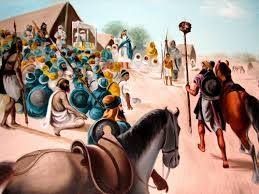Bhai Mehtab Singh Bhanghu


Bhai Mehtab Singh (d. 1745), eighteenth century Sikh warrior and martyr,
Early life
Bhai Mehtab singh was born in a jat sikh banghu family the son of Hara Singh, a Sikh of Bhangu clan of the village of Mirarikot, 8 km north of Amritsar.
Career as warrior
He grew up amidst the most ruthless persecution Sikhs suffered under the later Mughals, and like many another spirited youth joined one of the several small guerilla bands into which they had organized themselves after the capture and execution, in 1716, of Banda Singh Bahadur. Nadir Shah's invasion, while it violently shook the already crumbling edifice of the Mughal empire, so emboldened the Sikhs that they attacked and robbed even the invader's rear on his way back. Zakariya Khan, the governor of the Punjab from 1726 to 1745, further intensified his campaign against the Sikhs, forcing them to seek safety in hills and deserts beyond the central Punjab. Matab Singh, entrusting his family to the care of a village elder, and Natlha, a Khahira Jatt, went, according to his grandson, Ratan Singh Bhangu, the author of Prachin Panth Prakash, to Jaipur in Rajasthan, where he took up employment under the local ruler.
It was at Jaipur that he learnt how Massa Khan Ranghar, the new kotwal (officer-in-charge) of Amritsar, had occupied the holy Harmandar and converted it into a pleasure house. Resolved to avenge the sacrilege, Matab Singh left forthwith for Amritsar, accompanied by another bold warrior, Bhai Sukha Singh of Marhi Kambho Ke village in Amritsar district. They disguised themselves as tax collectors carrying on their backs bags seemingly filled with money. "It was a scorching noon of the month of Bhadori," narrates Ratan Singh Bharigu. "A strong wind raised a lot of dust, giving the two an excuse to cover their faces. Massa [inside the sacred sanctuary] was enjoying music appropriate to the rainy season. The guards were either resting under shelters or listening to the songs of the dancing girls. The two [Matab Singh and Sukkha Singh] got their God given chance. They hid their horses and spears outside the main entrance, one at either side, concealed their swords under their armpits, and advanced as if they were just some soldiers who had come with their collection of tax. Walking smartly, they reached where the mrdang [Indian doublesided drum] was being played. One of them immediately drew his sword and severed Massa's head like a gourd is plucked off the plant, while the other removed the ornaments from the body. There arose an instant tumult, but the two rode away on their horses and vanished into the forest." This happened on 11 August 1740.
Matab Singh's ancestral village of Mirarikot was raided by a strong military contingent under Faujadar Nurdin. Naltha, the village elder, and his son, nephew and two servants were killed while attempting to escape with their ward, Rai Singh, the young son of Matab Singh. Rai Singh was also grievously wounded and was left for dead. But of Matab Singh there was no trace, until five years later, when on receiving the news of the arrest of Bhai Taru Singh, he surrendered himself voluntarily to die by Bhai Taru's side. The harshest torments were reserved for both. Bhai Taru Singh had his scalp scraped from his skull with lancets and Matab Singh was broken on the wheel in the Nakhas square in Lahore.
References
http://www.sikhiwiki.org/index.php/Bhai_Mehtab_Singh
http://www.sikh-history.com/sikhhist/warriors/mahtab.html
1. Bharigu, Ratan Singh, Prachm Panth Prakash. Amritsai, 1914 2. Gian Singh, Giani, Twarikh Guru Khalsa [Reprint]. Patiala, 1970 3. Gandhi, Surjit Singh, Struggle of the Sikhs for Sovereignty. Delhi, 1980

